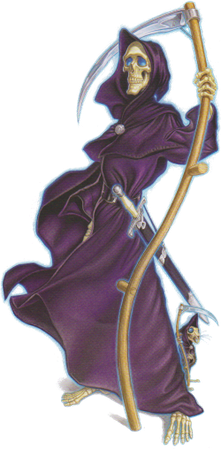Death (Discworld)
| Death | |
|---|---|
| Discworld character | |

Death as illustrated by Paul Kidby in The Art of Discworld.
|
|
| First appearance | The Colour of Magic |
| Created by | Terry Pratchett |
| Information | |
| Associations |
|
| Location | Death's Domain and everywhere else |
| Also in | Every Discworld novel except The Wee Free Men and Snuff |
| Notes | alias Bill Door (Reaper Man), Beau Nidle (Soul Music), and Mr Scrub (Soul Music) |
Death is a fictional character in Terry Pratchett's Discworld series and a parody of several other personifications of death. Like most Grim Reapers, he is a black-robed skeleton usually carrying a scythe. His jurisdiction is specifically the Discworld itself; he is only a part, or minion, of Azrael, the universal Death. He has been generally used by Pratchett to explore the problems of human existence, and has become more sympathetic throughout the series.
Death has appeared in every Discworld novel, with the exception of The Wee Free Men and Snuff, and had a possible cameo at the end of Johnny and the Dead (the character was not identified, but spoke in unquoted small caps). The Discworld books with Death as a leading character, starting with Mort in 1987, are:
Death's hollow, peculiar voice is represented in the books by unquoted Small caps; since he is a skeleton, he has no vocal cords to speak with, and therefore the words enter the head with no involvement from the ears. His "voice" is often described using a morbid metaphor, such as two concrete blocks being rubbed together, or the slamming of coffin lids; these descriptions have become less frequent in later novels. In the first Discworld novel, The Colour of Magic, as well as in Eric, all pronouns referring to Death are capitalized; thus, for example, "he" is written as "He." This is usually reserved for the Discworld gods and is not featured in any of the other novels.
Death is not invisible; however, most people's brains refuse to acknowledge him for who he is, unless he insists. Under normal circumstances, only those of a magical disposition (e.g. witches and wizards), children, and cats can see him, or allow themselves to see him. Due to his eternal nature, Death can ignore such things as walls and magic spells; he exists throughout all time, so things lasting merely centuries are not as real as he is. He can adjust time with regard to himself and others near him, completing tasks very rapidly from a normal perspective. He can only go where people believe in death and can only see people who can die. In this sense, he is similar to the gods of the Discworld, in that he is powered by mortals' collective belief in him.
...
Wikipedia
